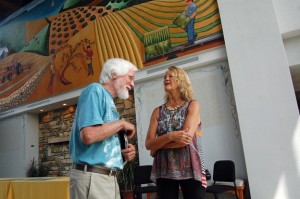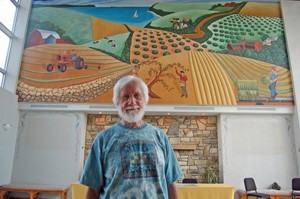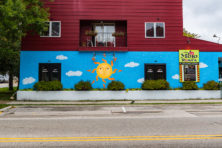DCA Mural Artist Reunited with Work
- Share
- Tweet
- Pin
- Share

David Giffey talks on July 8 with his friend Anne Haberland Emerson, who was instrumental in supporting the building of the Door Community Auditorium, where Giffey’s two murals are displayed. Giffey was seeing the murals for the first time since he finished them 20 years ago.
Seeing his creation for the first time in 20 years, David Giffey’s blue eyes seemed to dance with joy and appreciation across the wavy waters of the mural “Door County/The Water” on the south wall of the Door Community Auditorium entryway.
“There’s the joy of designing,” Giffey said. “I remember the water was really fun to paint. I was trying to bring in different elements of color because water is not blue.”
Confronted by the Door County icons he was commissioned to portray in mural format in the early 1990s, Giffey had the look of a man seeing a dear, old friend after a very long time as he took turns gazing upon “DC/The Water” and, on the other side of the entryway, “DC/The Land.”
“I’m delighted to see it,” he said. “It looks very bright and lively to me.”
The premise of the murals from the start, he said, was to make it local.
“I was asked to focus on local people, people that are year-round residents,” he said. “That really suited me. I grew up on a farm in Wisconsin and have a lot of feel for people who live in the country. And, of course, Door County is like the Cape Cod of the Midwest, so there is the water. It was decided to do one of the water and one of the land. Door County is such a visual place. Once you can see through the development, it lends itself to beauty.”
Giffey is a devoted artist who has done some very public art. In 1989 he did a series of eight-foot high paintings called Colleagues, featuring the Milwaukee Bucks, then manager Del Harris and owner Herb Kohl. Sports Illustrated did a story (“Those Byzantine Bucks”) about Giffey and the paintings in its April 24, 1989, edition, which pointed out that the players pretty much filled up the canvas but 5’7” Herb Kohl was left to levitate.
“Herb Kohl never bought them,” Giffey said with just enough irony to suggest the senator was suffering from canvas envy.
The Byzantine reference in that SI headline refers to what is perhaps oddest of all for a Wisconsin boy such as Giffey – he is probably best known as a Greek Orthodox iconographer. You can see his Byzantine iconography at the Assumption Greek Orthodox Church of Madison as one example of his work in that area.
But he is also a writer/reporter, Vietnam vet and peace activist. He confronts all those facets in his book Long Shadows: Veterans’ Paths to Peace, which includes a foreword by the late historian Howard Zinn. Or there’s David Giffey’s Struggle for Farmworker Justice, which is in the hands of the Wisconsin Historical society, (wisconsinhistory.org/highlights/archives/2012/09/giffey.asp).
It was the writing/reporting side of his life that brought Giffey, a resident of Arena, Wis., back to Door County to see the two DCA murals again. He is a member of the International Society of Weekly Newspaper Editors, which was holding its annual convention at St. Norbert’s College in De Pere. A busful of editors was heading up to Door County and Giffey decided to meet them at the DCA. They were late, perhaps distracted by stuffed waffles at the White Gull Inn, he speculated.
Giffey’s reporting background – he served as editor of the Home News, the weekly newspaper in Spring Green, Wis., and was a reporter at the Appleton Post-Crescent in the 1960s – came into play in doing the murals. With the assignment of capturing the local flavor, he went exploring the county with a camera.
“I took probably thousands of photographs,” Giffey said. “I tend to do that. I overshoot. Then I edited them and made selections of compositions. The subject matter came from that.”
If you know the murals, “Water” shows commercial fishermen and shipbuilders; “Land” portrays fruit pickers and farmers.
“These are actually portraits of people who worked and lived in Door County. They are not fictionalized,” Giffey said. “The apple pickers, one was a local woman and one was a migrant worker from Latin America. I went to Peterson Shipbuilding. They built a huge tuna vessel. I toured there and took photographs. Then I went out with commercial fishermen, the Hickey brothers of Baileys Harbor, and took pictures of them. The photographs were inspiration for the murals.”
He then rendered the images and concepts in pencil before committing them to painted studies. Then he worked on the full-scale paintings in his home studio, a barn with 30-foot ceilings that can accommodate his penchant for large-scale projects.
“I love painting large. It’s a curse in a way,” he said. “I have painted hundreds and hundreds of what could be called miniatures, easel paintings. I just have a real love for being able to work large. It appeals to me greatly. It has a lot of additional demands. It has to be designed and painted so it’s best seen from a distance. So for me there’s a lot of examining it from different distances. The object is to make it pleasing no matter where you are. That’s my goal.”
The Lady Slippers and meticulously calligraphied donor names on the wall are also by Giffey.
“They, too, have held up really well,” he said.
The continued vibrant look of the constantly exposed painting was planned.
“It’s a testimony to the materials,” Giffey said. “We in America make really good plastics. I used liquitex acrylics, which is a very high quality. It should never fade or deteriorate at all, if nothing happens to the building.”
Home Sought for Mural Photos
The photographs artist David Giffey took of Door County people and places more than 20 years ago as studies for the two 13’x29’ murals he did for the Door Community Auditorium contain a lot of county history, but are just sitting in storage at his home.
“I would be happy if there were a repository for some of those photographs,” Giffey said.
The problem is, Giffey was shooting pre-digital, so the hundreds of photos are print and negative.
“I don’t have graduate students to digitize them,” he said.
However, if anyone is interested in doing something with the photos he took for the mural project, contact Giffey at [email protected].


